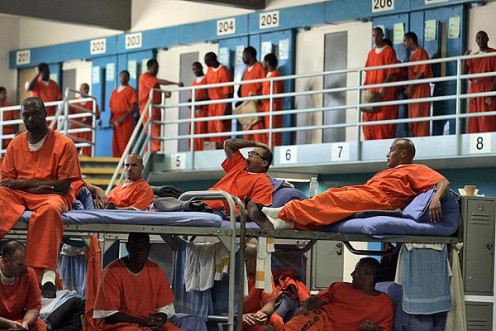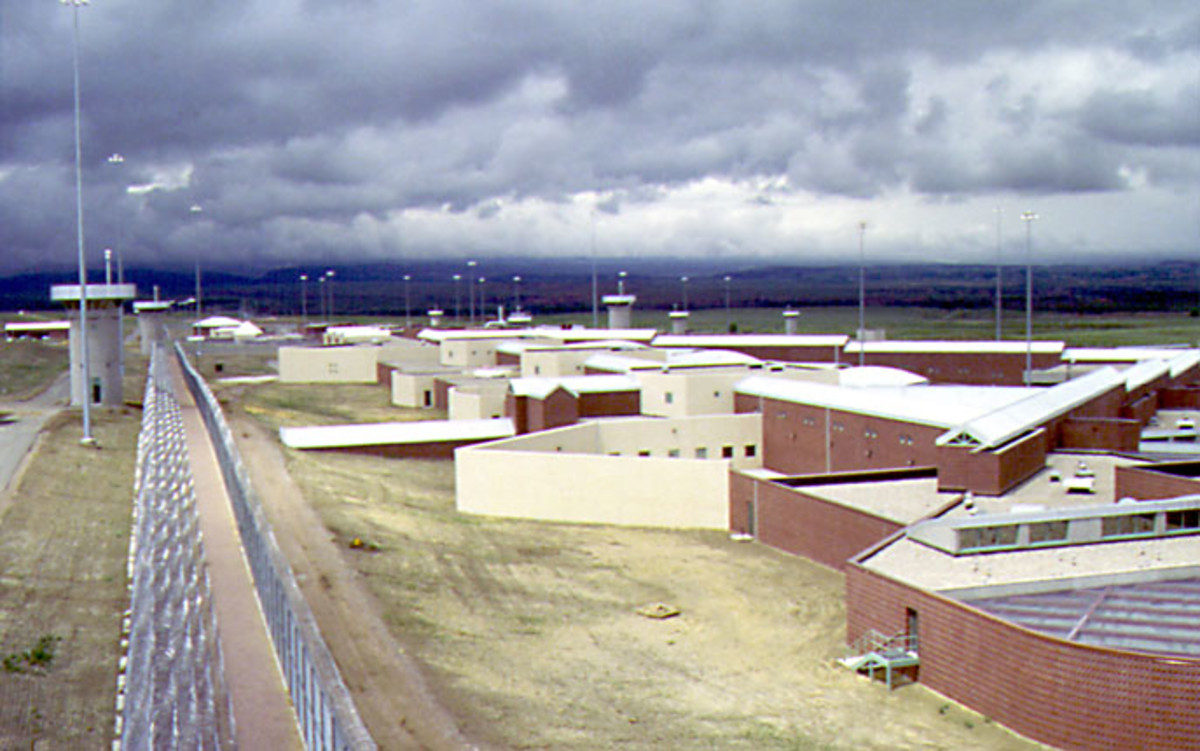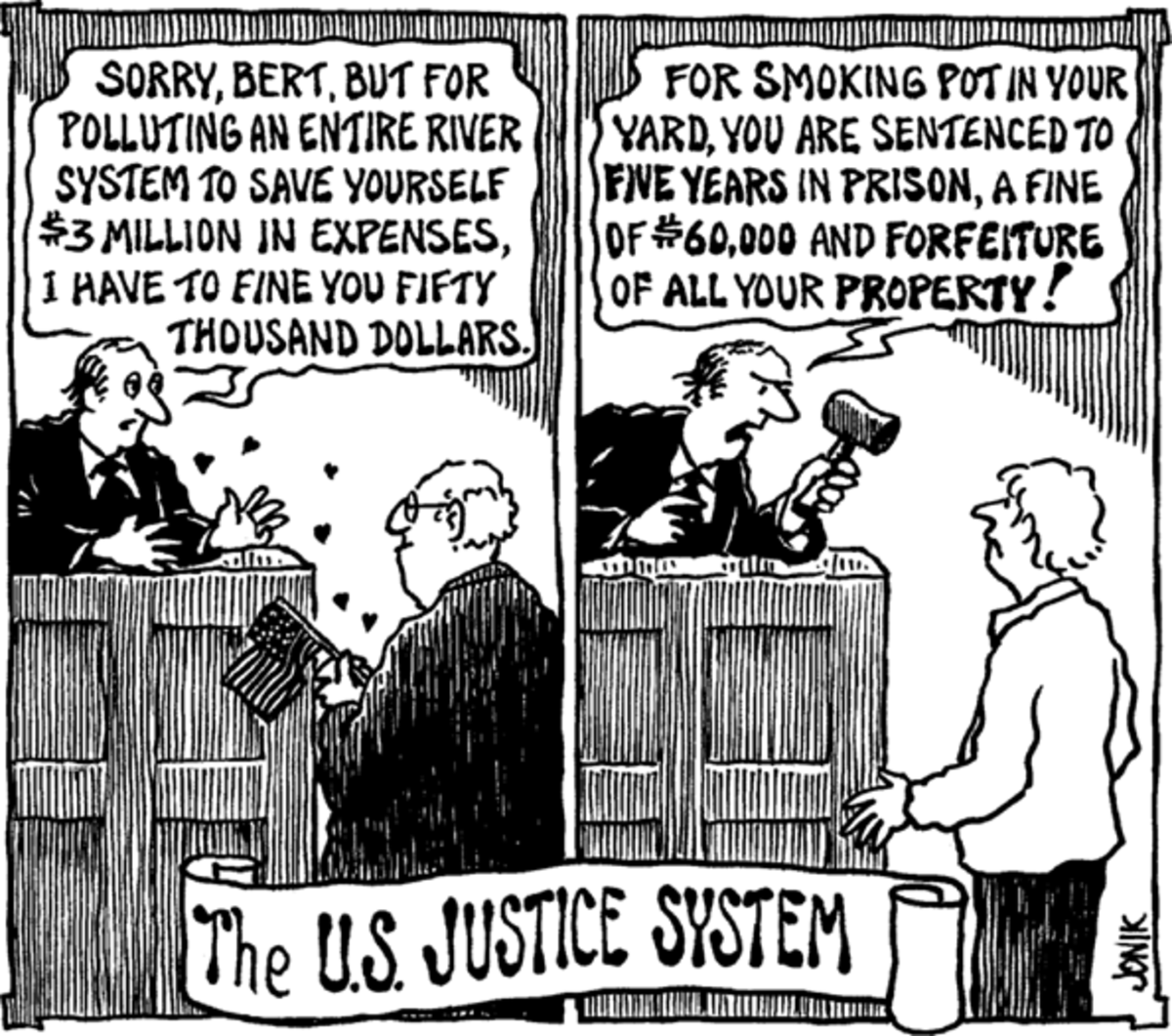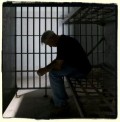CHANGING PRISON OVERCROWDING: SENTENCING ONLY VIOLENT & REPEAT OFFENDERS
Prison Overcrowding
CHAPTER I
INTRODUCTION
For a society that is so focused on violence in the world it doesn't make sense to waste extremely expensive prison space by quarantining nonviolent people when other methods of rehabilitation could first be utilized. We have shifted away from the prison era of warehousing people who fray from the norms of society decades ago so why then are Americans still geared towards punishments that throw away the key and make offenders someone else’s headache? The focus of this thesis is to review the problematic issues that surround prison overcrowding at the federal and state levels in our nation. One of the largest issues facing Corrections today is the absence of proper programming and treatment; the dangers of deprived conditions in confinement; and using forceful techniques for institutional control. Sadly, overcrowding issues have plagued our American Prisons for over 30 years and we continue to make it an out-of-control issue because our justice system continually tries to rectify the problems with building more institutions to add more space for more offenders, never fully focusing on the individual needs of the offender or taking a proactive approach towards crime.
This paper attempts to define not just the reasons for overcrowding, but discusses how public opinion as well as how the media influences the outcomes of sentencing in the courtroom and changes the standards of prison administrators. It also explains a more viable solution to the grand-scale problems behind overcrowding. Knowledge of the subject is the first step to understanding how detrimental prison overcrowding can be on so many different levels. The way to change the issue is to fully educate oneself not just about the reasons but about a more viable solution to control as well as handling the problem once and for all.
CHAPTER II
NEED FOR STUDY
Purpose
There is a both an informative as well as exploratory purpose behind the research project. The first is to show professionals in our criminal justice field as well as in the general population the importance of prison overcrowding and how it plays a major role in society as it continues to rage out-of-control nationwide. Without the basic understanding of the nature of overcrowding it will remain unchanged. In order to counteract the damage that has already been caused by the lack of understanding behind the issues education on the subject is paramount to force courtrooms to finally take a stand in opposition of current trends for overcrowding that obviously do very little to change the problem.
The second reason behind the thesis is to explore other methods that haven’t been used which involve only sentencing violent and repeat offenders to prison and misdemeanors and non-violent drug offenses through established drug courts and community correctional programs such as (Half-way houses, drug rehab programs, Day Treatment Facilities, and house arrest or probation and parole).
Theoretical Framework
Theory behind any research topic is an extremely important aspect to formulating a good research project. In its very essence it is the explanation behind the problem you are observing. A theory has been verified multiple times by detached groups of researchers. A single researcher cannot make a theory only a hypothesis.
For this research project the use of Meta- Analysis Research is most fitting because this form of research is a statistical technique that summarizes as well as reviews a previous study or quantitative research. Through the use of Meta- Analysis a number of questions can be investigated so long as a reasonable amount of primary research already exists on the subject. Meta-Analysis can be used as guide-work to answer such questions as: “Does what we are doing make a difference to (X)?” The main appeal to this form of research is that it combines all the research on a single topic into one large study with several different participants as well. A theory has been established for why prison overcrowding has continued to erode the Correctional Systems of America. In Meta-Analysis the many existing theories behind prison overcrowding can be combined in order to form a more substantiated approach to rectifying the issue of overcrowding. Throughout the research you will find that the solution to the issue behind Correctional Overcrowding may not be just one thing but a culmination of several different approaches that together can form a solution through the use of Meta-Analysis it makes it possible to review several solutions and theories in the research. For example: Would sentencing only violent and repeat offenders truly change overcrowding in the prison system? Or is it more a number of theories combined that will make the difference?
Initial research has already been conducted during a phase when prison overcrowding was at its initial peak in the mid 70s when prison officials and the correctional system showed a need to understand why our prisons were becoming so overwhelmed. Our Correctional System has had several possible theories of reform for years that they have failed to utilize effectively to obtain results. The following study will not only show what has been done in the last 30 years to combat prison overcrowding but will explore other possible reforms still need to be made if we are ever to regain control of our prison system and sentencing guidelines. It will discuss using alternative sentences for non-violent offenders more than ever before and will attempt to confirm the relationship between current and past sentencing guidelines that continue to fuel overcrowding over the last several decades.
CHAPTER III
LITERATURE REVIEW
Defining Concepts
Before a person can fully understand where the issue of prison overcrowding is taking the future of corrections we must first define and understand when prison overcrowding first began. Policies such as mandatory sentences, get tough laws, and the increased pressures from state correctional systems in the reduction of institutional populations has been rapidly changing the way in which American prison’s and probationers deal with crime. The Three Strikes Law is a law that was enacted out of California in 1994; the law approved a mandatory 25 to Life prison term when an offender is convicted of a third charge. The law also doubles the prison terms for a second-time offender. While many politicians at the time thought that the newly get-tough on crime measures would be a positive transition for cracking down on criminal activity the laws have had a counter effect and have directly increased pressure on overcrowding issues ever since the law was promulgated. The original intent of the Three Strikes Law was to crack-down on violent criminals but ironically mandatory sentencing sanctions are simply lumping serious and violent offenders with offenders such as: local derelicts and misdemeanants.
Diversion and Intermediate Sanctions are an established policy in some jurisdictions that is designed to divert the non-violent offender away from the criminal justice system. Some of these diversion programs include: Community-Based; Police-Based; Court-Based (Pre-Trial Intervention Program); Drug Courts; Intensive Supervision Probation (ISP); and Shock Incarceration (Boot Camps). Intermediate Sanctions can include: fines; day reporting centers; restitution; house arrest & electronic monitoring; and community service work under the supervision of a probation and parole officer.
Research Facts
Today more than 1 in 4 of the largest jail’s are under court orders to limit their populations as well as to improve specific conditions in regards to confinement such as: food services, medical, fire hazards, inmate classifications, and segregation policies.
Twenty-five of the largest jails in the United States house 31% of the nation’s total amount of jail inmates, 36% of those are exceeding their capacity. Most prison administers will admit to researchers that all the flexibility in the jail is absent when dealing with housing and the classification of their inmates if they are running at 90% capacity. In 2003, the largest jails were at 90% of capacity (Allen, Latessa, Ponder, & Simonsen, 2007, pp.104-105).
One in Thirty-Two adults and one in twenty adult men are today under some form of correctional supervision in the United States; one in eight black men ages 25 to 29 is in prison. In total, black men are imprisoned at a rate greater than seven times that of white men (3,405 to 465 per 100,000)
Currently 482 Americans (915 Adult Males) in prison for every 100,000 citizens which is the highest known rate for any industrialized nation. By 2007, our nation should reach 1.6 million Americans in prison.
In California alone, where the Three Strikes Law originated from nearly 75% of 2nd strikers and 50% of 3rd strikers are for non-violent and non-serious offenses. California has convicted 4,468 offenders on the third strikes law since 1994 (Murphy, 2000).
Scope of Problem
The issue of overcrowding is definitely not a recent one. As previously stated it has remained one of the largest problems that the administrators of American prisons and the State, Local, and Federal prisons have faced for over thirty years. Beginning with a massive influx of prisoners in the late 1970s and early 1980s prison populations grew to what scholars considered an unprecedented amount. Many prison systems grew to the point that difficulties arose with prison officials keeping track of inmate names as well as the locations of all the facilities that were in their system, which said nothing about care of inmates or focusing on supervision. The two largest prison systems in the United States are California and Texas they also experienced rapid growth California’s prison population over the 30 year period has grown eightfold from almost 20,000 in the 70s to well over 160,000 prisoners. In Texas over the five year period from 1992-1997, the prison population doubled when nearly 70,000 additional prisoners were added to the prison roll. Texas operates over 80 prison alone and since the 90s has obtained the highest incarceration rate in the nation. When prison systems continue to grow at these exhausting rates we are bound to see a wide variety of negative issues that plague correctional systems. If an institution is running over maximum capacity obviously adequate inmate care and health concerns arise such as: mental health, behaviors and inmate morale, high blood pressure, and lack of care for inmates with extreme disabilities. Many studies have concluded that the psychological toll on prisoners can become substantial leaving the safety of those inmates as well as other general population and staff under question. Another issue that can arise is the amount of inmate disciplinary actions have been known to increase in prisons that have overcrowding issues which in turn feeds more violence in the institution. The overcrowding of these institutions no doubt forces prisons to become a more painful, harmful, and undoubtedly increasingly dangerous to be housed in (Haney, 2006 pg. 1-3).
Jails are already overcrowded and full-control over many institutions is next to impossible, sadly many institutions have simply become dumping grounds where very little is accomplished other than locking up, and feeding the population. Over the years the improvements that have been made have become diminished due to overcrowding and by the increase of violent populations in prisons.
Since the 1980s, the United States has witnessed an unprecedented number of prison expansions in our long history of this country or even in the world. The increase in numbers has been attributed to fear of crime and the growing amount of criminals nationwide, the perception by the general population of being victimized as well as increased media coverage on “get-tough legislations, selected prosecution of violent offenders, and the impact of the so-called War on Crime with increased severity and length of the new sentencing initiatives.
Despite the facts that our nation has opened or expanded an additional 300 prisons in less than ten years, the average prison space that is available to inmates has dropped by over 10% and prison overcrowding continues to rage out of control, especially since crime is more out of control than ever with violent as well as drug-related crimes (Allen, Latessa, Ponder, & Simonsen, pp. 172).
With regards to affects of overcrowding on inmates themselves previous research has indicated that not only can fewer programs be made to inmates, but also their recreational opportunities are much fewer. The health and safety is the most troubling because of the rates of suicide, deaths, homicide, inmate assault, and disturbances have all increased as the prison populations nationwide continue to grow. These factors are all the same despite whether an inmate is being housed in a maximum, medium, and or low security prison and data usually skyrockets as inmate populations house more and more violent individuals (Allen, Latessa, Ponder, & Simonsen, pg.172).
Texas Experience
It is clear that the issue of overcrowding is a major issue plaguing institutional management in this country; this is especially true in states like Texas, where the federal government, in the case of Ruiz v. Texas, declared the entire department of corrections completely unconstitutional. As a result of the Ruiz decision, the federal government much more actively monitors every aspect of the Texas Department of Corrections- Institutional Division for over 20 years now. In an attempt to regain control over their department of corrections and diminish federal control as well as the shed prison overcrowding issues, as well as to avoid future lawsuits, an unprecedented number of new prisons were built in a very short period of time. In August 1993, the Texas Department of Criminal Justice, one of the largest correctional systems in the entire world, operated 54 inmate facilities. By August 1998, the number of correctional facilities in Texas doubled further housing prisoners in 107 correctional facilities. From the Texas Department of Corrections, Executive Services, David Stanley reported that Texas prisons will soon be at maximum capacity again. In August 1997, Texas men’s prisons were at 98% of their capacity and the women’s prisons approached 85% of their designed capacity. In 2008, there were 126,000 men and 10,000 women incarcerated in Texas prisons with estimates that the men’s prisons will have reached maximum design capacity sometime this current year (Hickey, 2008 pp. 206-207).
Global Incarceration Rates
Because of the United States misguided outlook on incarcerations and punishment we have seen a rise in the sentencing and incarcerations for all forms of crime. Even the most minor crimes on probation or parole have one time lead to inside the prison walls. With this being said it isn’t a surprise to most people that the United States incarcerates the largest number of people worldwide. Some of the individual states in the U.S. incarcerate up to six times as many people as do other nations of comparable populations. The U.S. also incarcerates the most women worldwide and crime rates do not account for incarcerations.
In comparison to the world’s most populous countries the 2.2 million that were incarcerated in 2006 were 153% higher than Russia; 505% higher than Brazil; another 505% higher than India; and over 2,000% higher than Indonesia, Bangladesh, or Nigeria. These incarceration rates are anywhere from 4 to 7 times higher than the other western nations like: United Kingdom, France, Italy, and Germany and up to 32 times higher than the nations with the lowest rates such as Nepal, Nigeria, and India (Hartney, 2006).
Costs of Overcrowding
Current projections by researchers estimate that by 2011, the U.S. Prison population will continue to increase by 13% which is triple the growth of the entire U.S. population. The increase will be over 1.7 million incarcerated individuals this increase will cost the American taxpayers as well as local and state budgets an estimated $27.5 billion and then another 4 million individuals will be at the same-time on probation or parole. The average annual operating cost per state is $23, 876 or $65.41 per day (Alcohol Monitoring Systems, 2009).
In California, the average operating cost per year for each inmate is $36,000 and rising. The state prison budget is $8.2 billion, and an additional $2 billion to $4 billion more is needed to “build-out” the overcrowding problem. According to these figures this is more money than the state of California spends on higher education.
A study that was conducted by Integrated Substance Abuse Program at UCLA showed that non-violent offenders who have completed a drug treatment program save California money. For every $1 that California spends $4 is returned to the state budget. Over the past five years since they began the study this treatment option has saved California a total of $800 million, which is a startling sum compared to what they spend to incarcerate and house non-violent offenders (Beck-Brown, 2006).
Solutions in Overcrowding
Part of the issue with overcrowding is that the sentencing courts have a major communication barrier with correctional agencies. When the courts impose a sentence on an offender the judge rarely states a clear purpose for the sentence or elaborates on the process by which corrections is supposed to achieve it. When the correctional agencies are left in the dark and guessing, they automatically revert to the generic penal system which embodies: prison, probation, or parole. For the criminal justice system to ever surpass old sentencing guidelines and to work in harmony with corrections a major restructuring of sentencing and the courts needs to be undertaken, the sad part is that while most of the criminal justice system is aware of this fact no one seems to be in complete agreement for how to solve the problems with the current system. The restructuring needs to take place from more imaginative judges and innovative measures by criminal justice professionals both classes have the practical knowledge that will be necessary to restructure and transform the system (Smith & Dickey, 1999).
We have discussed previously the use of Indeterminate Sanctions as an effective means of cutting-down on prison overcrowding, but even those sanctions need more attention from lawmakers as well as state and community jurisdictions to gain more funding and increase the potential of community treatment programs for them to maintain success. Channeling non-violent and misdemeanant offenders into a community-based correctional treatment continues to prove to researchers that with the right programming not only does it avoid incarceration but in many cases chronic recidivism. Indeterminate punishments have been designed for offenders that are believed to pose too much risk for probation service alone but not enough to risk being sent to prison. These sanctions are generally less expensive than incarceration in jails or prisons, and are believed to offer more rehabilitation and reintegration potential than incarceration can. Through sentencing only the violent and chronic offenders to longer sentences and using indeterminate sanctions and drug courts, mental health courts, and other community programs we will begin to regain control over corrections again.
Public Opinion & Media Influence
The media goes a long way to spin an out-of-control picture for the general population. Every night you watch the news you can find reports world-wide of more crime and violent acts which provides the appearance to the general population that violent crime is still very much out of control a growing menace by: guns, gangs, and drugs and the solution is mandatory minimum sentences and the Three Strikes Law, or so says the government because of public pressure for harsher sentences on all offenders.
Public opinion surveys that are routinely conducted prove that when the general population is provided with more facts and a wider knowledge base of the mandatory minimum sentences they disagree and oppose those laws, but when the wording of the survey questions ask questions like: “should violent criminals be sent to prison longer?” of course they overwhelmingly answer yes because as we all know some surveys are geared towards engaging quick and emotional responses from their respondents. Every-time a new high profile crime appears in the media Conservative Lawmakers take it as the perfect opportunity to respond to the crowd with a new mandatory-minimum sentence or make the existing minimum tougher and liberals will then have no grounds for which to rely on. The result will be another rise in sentence severity, prison populations will again surge and swell, correctional budgets will soar once more, and it will again make little to know difference in the overall point of the criminal justice system- public safety (Gardner, 2007).
Sentencing Violent & Chronic Offenders
Before you can fully understand the idea behind increasing maximum sentencing for first-time violent felonies and holding those that are chronic offenders that are progressively getting worse in their crimes it is important to understand the demographics of those that are already institutionalized. According to the Bureau of Justice Statistics Sourcebook at least half of the prison or jail inmates in 2002, were being held for either a violent or drug offense, which has virtually gone unchanged since 1996. Drug offenders, alone are up to 37% which represents the largest source of the jail population from 1996 to 2002.
Of the 272,111 inmates that were released from prison during 1994, an estimated 67.5% were rearrested for a felony or serious misdemeanor within 3 years of being released. 46.9% were reconvicted, and then only 25.4% of those cases are resentenced to prison for the new crime. Within 3 years of the release 2.5% of released rapists are rearrested for another rape, and 1.2% of those inmates who served time for a homicide are rearrested for a new homicide. In 1994 alone on any given day we had 234,000 offenders convicted of rape or sexual assault under the care or custody of corrections agencies, and nearly 60% of these offenders are under a conditional supervision in the community (Bureau of Justice Statistics, 2007).
Another more recent survey conducted by the National Crime Victimization Survey (NCVS). In 2007, U.S. residents that were over the age of 12 experienced approximately 23 million crimes, which were broke-down by the following: 76% (17.5 million) of the crimes were property; 23% (5.2 million) were crimes of violence; and 1% (194,100) were personal thefts. In 2007, for every 1,000 rapes, 1 rape occurred; 1 assault with injury occurred; and 2 robberies (National Crime Victimization Survey, 2009).
It’s a strange balance where violent sexual offenders and those that were previously convicted of violent felonies are able to receive early release on a first offense and be monitored by community programs for prior offenders, but the non-violent misdemeanant offender and those convicted on drug charges are incarcerated for a sentence of double or triple the normal sentence.
If we sentence only the violent and chronic repeat offenders for longer sentences the first time without the option of early release or “good time” it will cut down on recidivism and more violent crimes in the community when the violent offender is thrust back into the community. The danger with housing a non-violent offender with different issues with those that are convicted of violent felonies the non-violent offender, often times will be forced to defend themselves to secure their safety and in turn over-time can have a hardening effect over the offender which can lead to progressively more violent crimes when they are returned to society.
Alternative Programming for Non-Violent Crimes
The warehousing of offenders or suspected criminals in detention facilities is as old as the very idea of crime, but after the onset of prison overcrowding issues more and more local municipalities have been finding a need for alternative programs to incarceration. Incarceration is one of the most severe punishments that the criminal justice system can dull out and still one-half of all people in local jails are simply awaiting their trial, which means we are using one of our most severe sanctions against someone that hasn’t even been found guilty of their crime. Because of extended confinement cases with people that are presumed innocent until proven guilty and then later found not-guilty, weekend confinement is a short-term incarceration that allows offenders to remain employed, but is a partial solution for accused misdemeanants to keep working until and or after they are found guilty, depending on the level of their crime (Allen, Latessa, Ponder, & Simonsen, pp.111-112).
Diversion programming is found to be effective when they are linked to a community-based correctional system with a multitude of levels of supervision as well as custody. Diversion is seen as a threshold of the community corrections system, which is designed to filter as many offenders as it can from the process before their conviction and labeling as a criminal (Allen, Latessa, Ponder, & Simonsen, 142).
The major impetus for the development and the expansion of community corrections and the intermediate sanctions is of course, the overcrowding of our prisons. Most of our repeat offenders receive increasingly longer sentences. In the United States, the lag between the beginning of offending and eventual confinement as an adult is about ten years. This means, persistent offenders are more likely to have been subject to other correctional control (fines, day attendance centers, restitution orders, house arrest, and even electronic monitoring while they are in the community before their first incarceration.
Intermediate sanctions provide mid-range dispositions that seem to better reflect the severity of the offense than probation and or imprisonment. Many offenders can best be served by a reintegration program, but some are thought to be too dangerous to be released to traditional probation supervision with an infrequent face-to-face contact. Therefore a continuum of sanctions have been developed from probation to imprisonment: restitution; fines; day fines; community service; intensive supervised probation; house arrest; electronic monitoring; shock incarceration (which includes shock probation and shock parole as well as boot camps); and half-way houses. Also in more recent years the courts have seen many cases of drugs and mentally ill defendants as a result of this we have seen an explosion of what is known as therapeutic courts otherwise known as drug courts, mental health courts, and domestic violence courts. The greatest numbers of these specialty courts are from drug courts which divert drug abusive offenders to an intensely monitored treatment rather than incarceration. The purpose of these courts is to utilize the authority of the courts to reduce drug crimes by changing a defendant’s drug-abusing behavior. Under this concept, in an exchange for the possibility of dismissed charges or a reduction of their sentence, a defendant is diverted to a drug court program in a variety of ways in the judicial process, depending on the circumstance of the case. The judge presides over the drug court proceedings; monitoring the complete process of the defendant throughout the multi-layered process which includes hearings, and prescribes sanctions and rewards when they are deemed appropriate in collaboration with the prosecutor, defense attorneys, treatment providers, and other staff (Allen, Latessa, Ponder, & Simonsen, 145-149).
CHAPTER IV
RESEARCH METHODOLOGY
Research Design
The following study has been designed as a multi-faceted empirical research project. While I don’t believe any research topic is solely based on either qualitative or quantitative. In this particular study because we already have a clearly established and well defined prior research on the subject of overcrowding the following study is mostly quantitative. The research design isn’t experimental, but rather was considered an unobtrusive measure which utilized a secondary set of existing data from the following sources of information: The first goal of the research is to measure a scope of how far the concept of prison overcrowding affects the prison population, and the nation. The scope recognizes not only how overcrowding relates to the inmates, but also to the officers and staff in the prison system. The research conducted attempts to show the monetary costs of prison overcrowding, as well as how the media and general public are capable of exerting control over the outcomes of sentencing in the courts.
Research data was first conducted for the sole purpose of defining overcrowding and who it affects from previously designed studies of researchers: Allen, H.E.; Latessa, E.J.; Ponder, B.S.; & Simonsen, C.E. in the book: Corrections in America: An Introduction (11th Ed.). As well as Haney, C. a professor from the University of California, Santa Cruz, who wrote a research article titled: Prison Overcrowding: Harmful Consequences and Dysfunctional Reactions. More data on the monetary costs of prison overcrowding was collected from Beck-Brown, D. in an article published by the San Diego Union-Tribune called: The High Cost of Prison Overcrowding in April of 2006; and another study conducted by Alcohol Monitoring System that reaches nationwide and publishes the cost per inmate for each state to house. The Alcohol Monitoring Systems mission is to determine whether alcohol offenders are the ones that are overcrowding the prison system.
More research was conducted on the demographics of the classification of inmates being housed in prisons nationwide in recent years has been compiled in support of the hypothesis that sentencing only violent and repeat chronic offenders will be a more cost-effective way of targeting prison overcrowding long-term. Data was taken primarily from the Bureau of Justice Sourcebook, and the National Crime Victims Survey.
Lastly, in an attempt to show that one of the main causes of prison overcrowding is due to specific sentencing guidelines, such as “Three Strikes Law” more research was conducted utilizing an article from Murphy, J published by Speak Out on June 12, 2000, and by Tonry, M. published by the U.S. Department of Justice called: Sentencing & Corrections: Issues for the 21st Century in September, 1999.
CHAPTER V
DISCUSSION
This study examines the scope of state and federal prison overcrowding nationwide. Previous research on the subject suggests that the effects of which continue to erode the foundation of the correctional systems across America because no set safeguards have been implemented that are known to combat overcrowding and recidivism rates continue to rise into uncharted territories. The thesis looks at who prison overcrowding affects most, how it affects prison administrators, officers and staff, inmates, and the general population. How the media and the general public’s opinions affect the sentencing structures of the courts. How Indeterminate Sentences like the Three Strikes Law affect the prison population. As well as why utilizing more community programs and intermediate sanctions for misdemeanants, and non-violent offenders can change the amount of incarcerations at the federal and state levels as opposed to our current trends of using taxpayer funds to build more prisons and expand existing ones which has been a proven failure in changing the prison populations.
CHAPTER VI
INTERPRETATIONS & CONCLUSIONS
This has been a difficult thesis because of the attempt to examine the full spectrum of affects of prison overcrowding that exist. Prison overcrowding is a multi-faceted subject whose full psychological effects will continue to elude those in the correctional system partially due to a lack of data on the inmate behaviors and feelings directly associated with overcrowding and because of the conflict of ideas between researchers about suitable punishments for lawbreakers. Previous research conducted by the Bureau of Prisons and other organizations can only measure that which is reported by inmates themselves, correctional staff, and prison administrators. On the other hand the monetary effects of prison overcrowding are a much more tangible quantitative data that the Bureau of Justice and other governmental agencies can calculate and are a more easily attainable figure which shows the affects of the cost of housing, food, and healthcare as per each inmate in the state and federal system.
It is also a difficult undertaking to develop a detailed hypothesis which would cover an issue that so clearly is interweaved in all aspects of corrections. It seems that the Criminal Justice System finds it much easier to spend money building more prisons and expanding existing prisons than to dig deeper and try to cure the source of crime and to develop a more detailed strategic five-to-ten year plan for changing the prison population because of the need to change sentencing guidelines in the courts.
Much of the statistical data that is conducted from the Bureau of Justice Statistics and the National Crime Victim Survey revolved around the offender crimes classifications for which crimes, the majority of offenders are incarcerated for nationwide. It is no surprise that much of the demographics show that property, drugs, and more non-felony convictions overwhelm prisons nationwide which further confirms the idea of non-violent offenders overcrowding prisons nationwide. Above all, the researchers whose information where evaluated for use in this thesis have a distinct outcry for a reevaluation of Indeterminate Sentencing and the Three Strike Law which has been proven to exacerbate the issues of overcrowding nationwide. Research has shown other more viable choices which deserve the chance to change the instances of overcrowding prison populations.
REFERENCES
Allen, H.E., Latessa, E.J., Ponder, B.S., & Simonsen, C.E. (2007). Corrections in America: An
Introduction. (11th Ed.). Upper Saddle River, NJ: Pearson Prentice Hall.
Beck-Brown, D. (April 27, 2006). The High Cost of Prison Overcrowding. Retrieved May 31,
2009 from San Diego Union Tribune Web site: http://www.signonsandiego.com/uniontrib/20060427/news_lz1e27beckbro.html
Bureau of Justice Assistance (n.d.). National Assessment of Structured Sentencing. Retrieved
May 13, 2009 from U.S. Department of Justice Web site: http://www.ncjrs.gov/pdffiles/strsent.pdf
Bureau of Justice Statistics (August 08, 2007). Criminal Offender Statistics. Retrieved May 13,
2009 from U.S. Department of Justice Web site: http://www.ojp.usdoj.gov/bjs/crimoff.htm
FBI, Uniform Crime Reports (2008). United States Crime Rates (1960-2007). Retrieved June
15, 2009 from The Disaster Center Website: http://www.disastercenter.com/crime/uscrime.htm
Gardner, D. (October 27, 2007). Stephen Harper “Gets Tough” on Crime. Retrieved May 26,
2009 from Ottawa Citizen Web site: http://mostlywater.org/stephen_harper_gets_tough_on_crime
Haney, C. (2006). Prison Overcrowding: Harmful Consequences and Dysfunctional Reactions.
Retrieved May 31, 2009 from http://www.prisoncommission.org/statements/haney_craig.pdf
Hartney, C. (November, 2006). U.S. Rates of Incarceration: A Global Perspective. Retrieved
June 21, 2009 from National Council on Crime & Delinquency Web site: http://www.nccd-crc.org/nccd/pubs/2006nov_factsheet_incarceration.pdf
Hickey, T.J. (2008). Taking Sides: Clashing Views in Crime and Criminology (8th Ed.). New
York, NY: McGraw-Hill Publishing.
Ingersoll, R.G. (1886). A Lay Sermon. Retrieved May 12, 2009 from
http://www.infidels.org/library/historical/robert_ingersoll/lay_sermon.html
Murphy, J. (June 12, 2000). Are Three Strikes Laws Fair and Effective? Retrieved May 31,
2009 from Speak Out Web site: http://speakout.com/activism/issue_briefs/1290b-1.html
Smith, M.E. & Dickey, W.J. (1999). A Plan to Reduce Prison Overcrowding and Violent Crime.
Retrieved June 1, 2009 from http://www.alec.org/am/pdf/Criminal_Justice_2007_State_Factor.pdf
U.S. Department of Justice (2007). Criminal Victimization. Retrieved May 13, 2009 from
Bureau of Justice Statistics Web site: http://www.ojp.usdoj.gov/bjs/cvictgen.htm
U.S. Department of Justice. (August 14, 2008). Drug Use and Crime. Retrieved June 8, 2009
from Bureau of Justice Statistics Web site: http://www.ojp.usdoj.gov/bjs/dcf/duc.htm#drug-related
U.S. Department of Justice (2007). Corrections Statistics. Retrieved June 21, 2009 from Bureau
of Justice Statistics Web Site: http://www.ojp.usdoj.gov/bjs/correct.htm
APPENDIX A
*Bureau of Justice Statistics- Drug Related Crime: reflects percentage of prison and jail inmates who committed an offense for drug money.
Offense
Local Jail Inmates-2002
State Prisoners-2004
Federal Prison-2004
Totals
16.4%
16.6%
18.4%
Violent
8%
9.8%
14.8%
Property
26.9%
30.3%
10.6%
Drugs
24.8%
26.4%
25.3%
Public Order
5.2%
6.9%
6.8%
U.S. Department of Justice. (August 14, 2008). Drug Use and Crime. : http://www.ojp.usdoj.gov/bjs/dcf/duc.htm#drug-related
*Uniform Crime Report (UCR) and Federal Bureau of Investigation reported in 2006, 5.3% of the 14,990 homicides narcotics were known to be related.
Drug Related Homicides
Year
Number of Homicides
% drug related
2000
13,230
4.5
2001
14,061
4.1
2002
14,263
4.7
2003
14,465
4.7
2004
14,210
3.9
2005
14,965
4.0
2006
14,990
5.3
FBI, Uniform Crime Reports (2008). United States Crime Rates (1960-2007). http://www.disastercenter.com/crime/uscrime.htm









